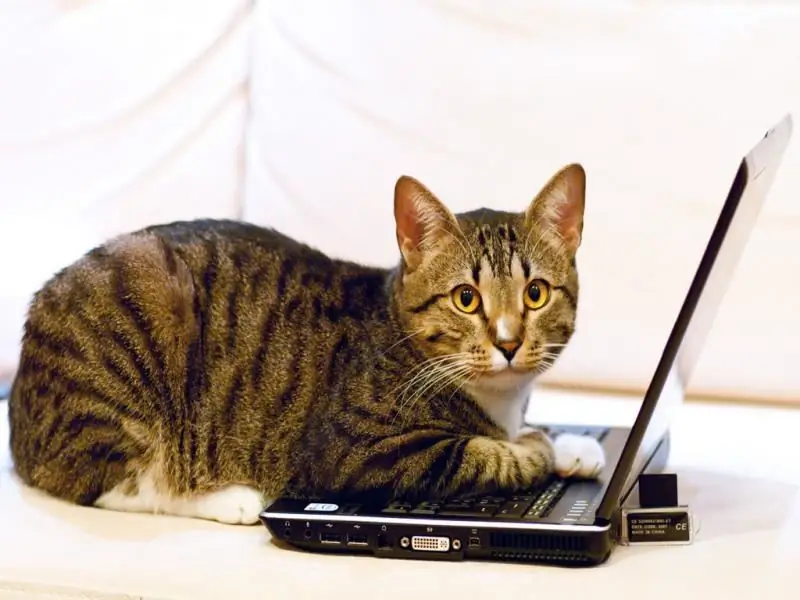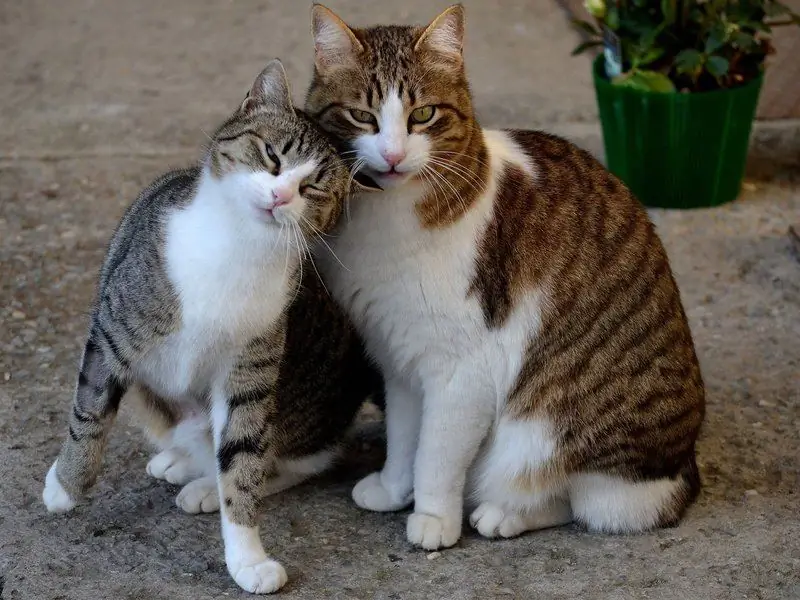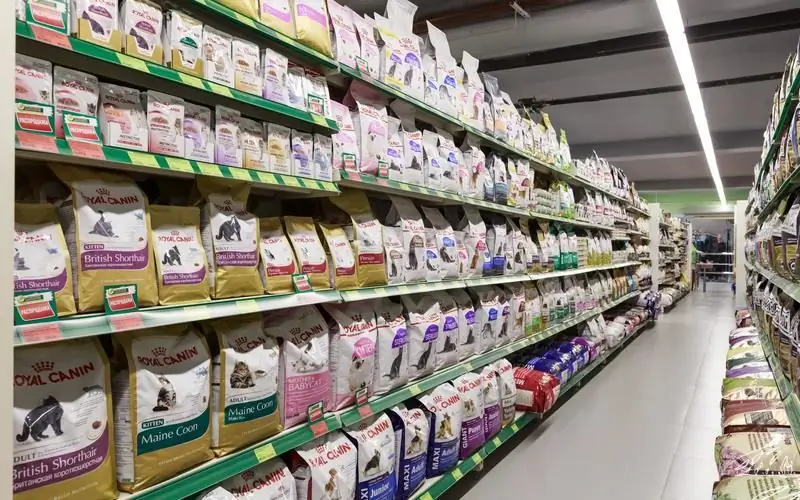
Table of contents:
- Author Bailey Albertson [email protected].
- Public 2024-01-17 22:26.
- Last modified 2025-06-01 07:32.
Feline Health Guard - Pet Vaccination Scheme

An important element in caring for a pet is taking care and attention to its health. There are dangerous diseases from which it is better to protect the animal in advance than to deal with the consequences later, so the issue of vaccination is relevant. Cat owners should approach this step with special responsibility, since all medical procedures must be performed correctly and, importantly, on time.
Content
-
1 How cat vaccines work
1.1 Need for vaccination for domestic cats
-
2 Types of cat vaccinations
-
2.1 Feline vaccination schedule
- 2.1.1 Table: Types of vaccines and vaccination schedule for cats
- 2.1.2 Photo Gallery: Vaccines for Cats
- 2.2 Adding the vaccine to the veterinary passport
- 2.3 Duration and price
-
- 3 Contraindications to vaccination
- 4 Preparing the cat for vaccination
- 5 Where and how are animals vaccinated
- 6 Rehabilitation and complications
- 7 Testimonials from cat owners about vaccinations
How cat vaccines work
Vaccination means the introduction into the animal's body of specially prepared microorganisms designed to develop immunity to a specific disease. The principle of action lies in the collision of the immune system with the pathogen in a weakened or dead form, which does not allow the disease to develop, but allows the defensive forces to get acquainted with its source and repel the attack in the future.
Depending on whether in this state the pathogen is artificially introduced into the body, they are distinguished:
- dead drugs - the causative agent of the disease has been killed in their composition. Often, to increase the immune response, a substance is injected with it to activate the inflammatory process at the injection site (this allows you to “inform” the body's defenses that an infection has penetrated), and then the drug will already be called adjuvant. The developed immunity is considered not very persistent, but there will be fewer side effects if the cat has hidden diseases;
- live modified preparations - contain weakened, but still living pathogens that can no longer cause disease, but are suitable for the formation of immunity. The formed defense is considered stable and of high quality, but there are risks of complications - if the pet was sick with something, experienced stress, etc., against the background of which the immunity was weakened, then the defenses may not cope even with the weakened virus and the disease will begin;
- live recombinant - the safest type of drugs, containing only part of the genetic material of the virus, which is necessary for the development of animal immunity, which significantly reduces the risks
The advantages of this method of protecting animals are:
- prevention of common infectious diseases;
-
admission to participation in exhibitions and competitions where there is contact with other animals;

Cat on show It is better not to go to the exhibition without vaccinations - the cat will come into contact with a large number of animals and people, which is extremely risky for an unprotected pet
- the ability to travel with a cat (for travel by transport and crossing state borders, you must provide a certificate of the pet's health with a list of vaccinations made);
- the opportunity to breed a pet (mating of thoroughbred animals is allowed only if the vaccination schedule is observed - this is necessary to reduce the risk of possible pathologies);
- cost savings. Vaccination is an inexpensive method of disease prevention, there is always an opportunity to choose between drugs from different manufacturers, choosing the most appropriate price. In addition, vaccinations will cost several times less than treating a pet in case of infection;
- calmness of the owner. In addition to getting rid of worries about the health of the pet, the owner of the cat does not have to worry about his health and the condition of other people whom the cat may bite in any given situation.
The procedure for administering vaccines against infectious diseases has its drawbacks, like any other medical manipulation:
- there is a risk of side effects in the animal;
- the risk of an allergic reaction to the components of the administered vaccine;
- the need to visit a veterinary clinic for a procedure, which is sometimes difficult for a modern person to find time for.
Need for vaccination for domestic cats
Some cat owners think that if the animal is domestic and not in contact with the outside world, then it is not necessary to vaccinate it. Undoubtedly, the risk of such a pet getting sick is much less than that of those that go out, but it exists, because the causative agent of the disease can enter the house with a person's shoes and clothes. The simplest example - the owner for a walk entered the feces of a sick animal and, without noticing this, returned home. The cat will only need to sniff the shoe to catch the virus.
Types of cat vaccinations
When thinking about vaccinations for your cat, you should know which diseases they can protect against:
- panleukopenia (or plague) is a contagious and deadly disease, mortality statistics are 90%. It affects the digestive system, respiratory system and heart, and causes severe dehydration. If the pathogen gets into the house, for example, with shoes, then neither washing the floors nor treating the room with disinfectant solutions will save the animal from illness. The distemper vaccine is generally well tolerated;
- rabies is a deadly disease (not only for animals, but also for humans). It is characterized by lesions of the spinal cord and brain;
- calcivirosis is a common respiratory disease transmitted by airborne droplets. Calicevirus infection leads to the death of every third sick animal, and is easily transmitted from one cat to another (even the feces of a sick cat can be sources of infection). It is manifested by an increase in temperature, inflammation of the mucous membrane of the eyes, the appearance of ulcerative foci in the oral cavity, and active salivation. In most cases, vaccination against calcivirosis is uneventful;
- rhinotracheitis is a respiratory disease caused by the herpes virus. It is accompanied by fever, inflammation of the upper respiratory tract, runny nose, inflammation of the mucous membrane of the eye. The probability of death is up to 20%.
There are vaccinations against other diseases, including feline peritonitis, giardiasis, chlamydia, bordetellosis, but they are not used so often. The fact is that their effectiveness has not been proven, and some are adjuvant (with additives to create an inflammatory process in the injection area), which causes an increased risk of negative reactions.
Depending on the number of infections to which the vaccine should form immunity, drugs are divided into:
- monovalent - the action is directed at one pathogen (for example, Nobivak Rabies);
- polyvalent - several components are injected at once, which makes it possible to form immunity to several diseases at once (Nobivak Trikat, Quadricat, etc.).
Cat vaccination schedule
There are general recommendations for vaccination of animals, but the specific regimen and dose of the drug is determined by the manufacturer. For this reason, before giving the vaccine, it is necessary to read the instructions, and not only the timing may vary, but also a number of contraindications and special restrictions.
Table: types of vaccines and vaccination schedule for cats
| Vaccine name | A type | Appointment | At what age can you be administered (first vaccine) | Re-dose | Subsequent revaccinations | Manufacturer |
| Nobivac tricat | Polyvalent, live | Against rhinotracheitis, calcivirosis and panleukopenia | 9-12 weeks | After 2-4 weeks | Once a year, annually | Intervet, Holland |
| Nobivac rabies | Monovalent, killed | Against rabies | 12 weeks | A repeated dose of the vaccine is not given | Intervet, Holland | |
| Leucorifelin | Polyvalent, live | Against herpevirus, calcivirus and panleukopenia | 7-8 weeks | After 3-4 weeks | Merial, France | |
| Quadricat | Polyvalent, killed | Against herpevirus, calcivirosis, rabies panleukopenia | 12 weeks | The second dose of this vaccine is not administered, a drug without rabies is required | Merial, France | |
| Felovax-4 | Polyvalent, killed | Against panleukopenia, two strains of calcivirus, rhinotracheitis and chlamydia | 8 weeks | After 3-4 weeks | Fort Dodge, USA | |
| Multifel-4 | Polyvalent, killed | Against panleukopenia, calcivirus, rhinotracheitis and chlamydia | 8-10 weeks | After 3-4 weeks. Third vaccine - after 5-7 months | Narvak, Russia | |
| Feligen | Polyvalent, live | Against calcivirosis, rhinotracheitis and panleukopenia | 8 weeks | After 3-4 weeks | Virbac, France |
Photo gallery: vaccines for cats
-

Nobivak Trikat - Nobivac Triquet is a multivalent vaccine for cats that protects against calcivirosis, distemper and rhinotracheitis pathogens
-

Nobivak Rabies - Noivac Rabies is a single-component vaccine designed to protect cats from rabies
-

Quadricat - The dose of Quadricat is two vials, one of which is a drug for the prevention of rabies, and the second is a polyvalent vaccine against calcivirosis, herpevirus and distemper
-

Multifel-4 - Multifel-4 is a vaccine for cats of Russian production that protects against 4 types of viruses at once
-

Feligen - French vaccine Feligen three-component and protects cats from rhinotracheitis, distemper and calcivirosis
Introduction of the vaccine into the veterinary passport
In the veterinary passport of the cat, all medical procedures and vaccinations must be recorded. Information must be entered in full:
- date of procedure;
- type of vaccine (in addition, a label from a bottle with information about the type of drug, its serial number, expiration date, etc. can be glued in);
- the stamp of the veterinary clinic, the name of the doctor who vaccinated, and his signature.
If there is no record in the document, then in the event of a disputable situation (for example, if a cat has bitten someone), it will be considered that the animal has not been vaccinated, since there is no formal evidence of this.

Information about vaccinations must be entered into the animal's veterinary passport
Terms of validity and price
The immunity developed by the injected vaccine depends on the type of drug and can last up to 3 years. However, its effectiveness is gradually decreasing, so it is recommended to revaccinate an adult cat annually. It should be understood that the introduction of a vaccine is not a guarantee that the animal will not get sick. This is primarily a preventive measure, which does not give a 100% guarantee. However, there is a huge plus in favor of vaccination - if the vaccinated animal still gets sick, then the disease will proceed much easier, and the risk of death, provided proper treatment, will go down to a minimum.
The cost of a vaccine depends on several factors at once: the manufacturer (imported drugs are always more expensive), mono- or polyvalence (funds for the prevention of several diseases are more expensive than for the prevention of one), the clinic's margin. For example, Nobivac Triket costs 550-600 rubles, while the Russian Multifel-4 will cost 250-300 rubles. In addition, the cost of vaccination includes the payment for the procedure itself - examination, injection and consumables. If the vaccination is the first, then the cat owner also needs to purchase an international veterinary passport.
Contraindications to vaccination
There are a number of contraindications, the presence of which precludes vaccination:
- age up to 7-12 weeks (restrictions vary depending on the type of vaccine). Small kittens do not yet have formed immunity, since they are protected by antibodies received from the mother-cat with milk. A defense mechanism that is not ready for stress simply cannot give an adequate immune response to the injected drug. If the cat is vaccinated, then with the vaccination for the kitten, you can wait up to 12 weeks, but if the mother is without the necessary injections, then the offspring should be vaccinated as early as possible;
-
disease. The basic rule of vaccination is that the animal must be completely healthy, otherwise there is a high risk of complications due to the increased load on the immune system;
contact with a sick animal. If the cat "communicated" with another pet that has a contagious disease, it is better to wait at least 2 weeks. If the symptoms did not appear immediately, this does not mean that the animal will not get sick, because each infection has its own incubation period (the period from ingestion to the left of the first manifestations of the disease)
- the period of changing teeth in kittens (4-7 months). Against the background of this process, a reduced level of immune defense is noted, therefore, an additional load on the body is not recommended;
- pregnancy of a cat (this is especially true for live vaccines that cause a strong immune response). Killed vaccines, if necessary, can be given during gestation of kittens. The limitation for all types of vaccinations is 2 weeks before the planned lambing and 2 weeks after it;
- less than 2 weeks after a course of antibiotics or other serious medications. The body needs to recover from stress so that the risk of complications after vaccination is minimal;
- less than 3 weeks after the surgery;
- a state of stress (moving, traveling, any change in the usual environment). Mental stress directly affects the level of immune defense, so it is better to wait at least a week after the traumatic event, and only then get vaccinated.
Preparing your cat for vaccination
Before being vaccinated, the cat must be properly prepared:
-
carry out preventive deworming with drugs Pratel, Prazicid, etc. (from worms) 10-12 days before the scheduled procedure. This is an obligatory stage, since the presence of parasites significantly weakens the immune system, and the vaccination can result in serious complications and illness (this is called a "breakthrough of post-vaccination immunity");

The cat is given a pill 10-12 days before vaccination, the cat must be given a drug for helminths
- get rid of external parasites - fleas and ticks, after processing with special means (Bars, Inspector, Advantage, etc.). Ectoparasites also provoke a load on the body, which will be unnecessary during the administration of the vaccine;
- to limit contact of a cat with other animals and refuse free range - you need to be completely confident in the health of the pet and its environment.
Before going to the veterinary clinic, make sure that the cat is feeling well, active and alert. There is no ban on feeding before the injection, it is just that the animal may get nervous, which is why the risk of vomiting is high, so on the day of the injection it is better to keep breakfast to a minimum.
Where and how are animals vaccinated
There is nothing complicated in vaccination, therefore, theoretically, the procedure can be carried out at home on your own, but it is better not to do this, but go to a veterinary clinic. First of all, home vaccination may be invalidated when processing documents for the export of an animal. Secondly, the owner himself will be responsible for the quality of the vaccine, because it is important to observe the correct transportation conditions and the so-called "cold chain" - temperature conditions in the range of 2 to 7 degrees, otherwise the drug will be spoiled.
The optimal solution is to contact a clinic where all the conditions for storing drugs are provided, and the staff knows how to handle them. The procedure itself takes place in several stages:
-
The veterinarian examines the animal, measures the body temperature, assesses the general condition. If the indicators are normal, then a decision is made to vaccinate. If there is a suspicion of a pet's illness, the event is postponed.

The temperature of the cat is measured Before the vaccination procedure, the doctor must measure the temperature of the animal
- The doctor takes the necessary vaccine out of the refrigerator, prints it and fills it into a syringe. At this stage, the specialist demonstrates to the owner of the animal the packaging of the drug, which indicates its name and expiration date.
- At the next stage, an injection is made. The drugs can be injected subcutaneously (in the area between the shoulder blades) or intramuscularly (in the thigh). If the vaccine is polyvalent, then it is drawn into one syringe, but if two different drugs are injected at once (for example, Feligen and additionally Nobivak Rabies for rabies), then each is drawn into its own syringe separately.
- After the procedure, information on vaccination is entered into the veterinary passport.
Kittens are often vaccinated at home - they call a doctor to carry out the procedure. This avoids the stress of the baby associated with the first trip from the usual home and from the mother to an unfamiliar clinic.
Rehabilitation and complications
Upon returning home from the clinic after the vaccination, the owner needs to closely monitor the condition of his pet. A normal reaction is some lethargy, a decrease in the activity of the animal and an uncritical increase in body temperature (1-1.5 degrees) for several days. The appearance of a tubercle and redness at the injection site is also within the normal range - this is a local manifestation of the body's protective reaction. The pet's food should be easily digestible, in order to avoid unnecessary stress on the body, it is important to provide a sufficient amount of drink and a favorable microclimate in the room (to prevent hypothermia). It is worth protecting the cat from contact with other animals during the formation of immunity to the introduced vaccine (usually 10-12 days).
If all the rules are followed, the risk of complications is very small (up to 1%), but it still exists. Possible consequences of vaccinations include:
- allergy to the components of the injected drug. Symptoms usually appear rather quickly (20-30 minutes after the injection), and include increased saliva production, difficulty breathing, inappropriate behavior, etc. If you have already left the clinic, it is better to return to it for the doctor to administer antihistamines to the cat;
- severe course of diseases that had no obvious symptoms before vaccination. This is true for cases where the vaccine was administered to a cat with a disease during the incubation period. An increased load on the immune system usually leads to serious complications that can lead to the death of the animal.
Vaccination reviews from cat owners
It is extremely important to take care of your pet's health, otherwise an accidental encounter with a dangerous infection could cost him his life. Vaccinations are designed for preventive purposes in order to minimize the risks of the animal getting sick. Cats are vaccinated for the first time at 8-12 weeks, and then injections are given annually to maintain the developed immunity.
Recommended:
Why Do Cats (including Pregnant) And Cats Dream: Interpretations Of Popular Dream Books, Descriptions Of Various Dreams About Kittens And Adult Animals

Why do cats, cats, kittens dream: interpretation from famous dream books. The meaning of the appearance of the animal, its condition and actions, as well as the sex of the dreamer
Life Hacks For Cats And Cats - Usefulness That Will Improve The Life Of Adult Pets And Kittens, Simplify Caring For Them And Ease The Life Of The Owners

How to make the life of a domestic cat better and more varied. How to arrange a place for a cat, a toilet, make toys and much more. Practical advice
Mating Cats And Cats: How Mating Takes Place, At What Age Should The First Mating Of Pets And Other Advice To Owners

The timing of puberty in cats and cats. First mating rules. Preparation for mating. Choosing a partner. Mating process of cats. Signs of pregnancy. Reviews
Classes Of Food For Adult Cats And Kittens: Description Of Species And Categories, Classification By Consistency, Dry And Wet, Age And More

What are the ready-made cat food. How do they differ from each other. What foods should not be given to cats
The Age Of Cats And Cats By Human Standards: A Table Of The Relationship With A Person, How To Calculate

The ratio of feline to human ages. How to extend your pet's life. Factors affecting a cat's lifespan. Video
